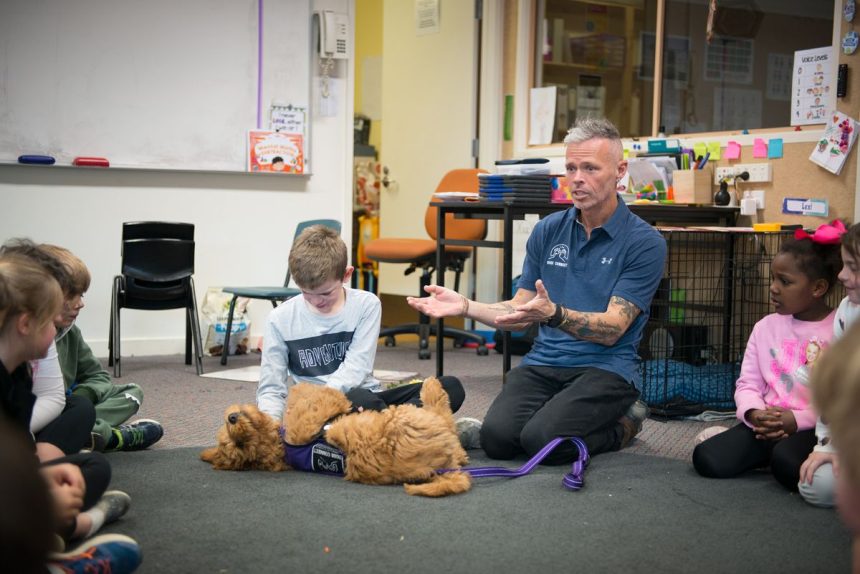Grant Shannon was a school teacher before founding Dogs Connect around ten years ago.
His motivation to approach the profession from a fresh angle came from working closely with a cohort of “particularly challenging young boys” and recognising the need to improve their social and emotional competencies.
But rather than feel burnt out by the pressure that need created, he says the opposite was true.
“I was fuelled by it,” he told EducationDaily. “I was especially concerned about their ability to empathise – and I love a challenge.”
When completing his masters degree required a final project that would change the culture in a school, Mr Shannon says “working with dogs was a no-brainer for me”.
“I’d had a close connection with them my whole life,” he says.
Nurturing sustainable connections
Since then, Dogs Connect has introduced dogs into more than 300 schools across Australia.
But just don’t call the animals they work with ‘therapy dogs’.
“We aim to create a permanent connection between a community and their dog, which leads to positive emotional and social impacts. We help communities think differently about how to achieve wellbeing,” Mr Shannon says.
‘Wellbeing dog’ wasn’t a common term when Dogs Connect began, he says, but it’s one he is proud to be connected to today.
“To make this about genuine wellbeing, it’s about creating bright moments, and for that to be really true, it needs to be about wellbeing for the dogs as well as the humans,” he says.
Teaching schools how to do that in a way that is sustainable is critical.
Instead of talking about ‘obedience’ and ‘handler’, at Dogs Connect, the discussion is around creating sustainable solutions for schools – and that means the focus is on the dog’s happiness and enjoyment, under the watchful eye of a ‘primary carer’.
That person doesn’t have to be a teacher, Mr Shannon told EducationDaily.
“It’s more important they are simply someone who can offer the right criteria. The dogs need to be dogs.”
It’s easy, he says, “to do this wrong and mean really well but to overstimulate dogs and stress them out”.
“Our goal is to help schools do this really well,” says Mr Shannon. “If this is done well, it should be really positive for everyone.”
The sustainability aspect means secondary (and tertiary) careers are also important.
Yes, the dog is part of its own household it returns to every night after its working day at the school is done, but, within the school setting, multiple staff members are trained to have a hands-on role with the care and management of each Dogs Connect wellbeing dog in each school.
When it comes to wellbeing dogs, bigger is better
For schools thinking about sourcing their own wellbeing dog, Mr Shannon has some tips and says, although a wellbeing dog can be a dog someone on staff already owns, or a purpose-bought puppy, success with a wellbeing dog comes from educating everyone who interacts with the dog to seeing it as a sentient being – and care for them accordingly.
To avoid any allergy issues, dogs that don’t shed are preferable. And although, ultimately, any well-behaved dog can succeed as a wellbeing dog, rather than choose dog breeds that are known for their strong hunting or herding instincts, Mr Shannon recommends schools look at varieties of ‘oodles’. He points to labradoodles (a labrador/poodle cross), or groodles (golden retriever x poodle) as a positive starting point. Australian cobber dogs are also good, he says.
‘Smaller dogs are vulnerable in a busy school setting,” Mr Shannon says. ‘Bigger versions of dogs have more of a presence.”
With a clear endorsement from both the Victorian Department of Education and the New South Wales Department of Education – Dogs Connect is listed as an evidence-based mental health program – Mr Shannon says the word is continuing to spread, as more schools across the country recognise the benefits that having a wellbeing dog on school ground can deliver.
“We have some schools that have multiple dogs, too,” he says. “One school has four.”
Looking after student wellbeing means understanding your wellbeing dog
For authentic connections to build between the dog and the students it works with, it takes time, says Mr Shannon.
“It needs to be mutual and reciprocal and respectful,” he says.
The cost of the Dogs Connect program is currently $7000 and includes a comprehensive online training program that can be shared with multiple teachers and staff members. Although it doesn’t include the cost of sourcing a dog, Dogs Connect can also help facilitate that and give guidelines of what to look for in an ideal wellbeing dog.
Their unique world-first wellbeing dog program is now being introduced to settings beyond the schoolyard, and into aged care, hospitals, prisons and emergency services.
“The wellbeing dogs we work with are selected for each environment. Every program we build is in line with the International Standards for Animal-Assisted Intervention,” says Mr Shannon
For schools adhering to trauma-informed education practice, the presence of a wellbeing dog can make a powerful difference,” he says.
“In those moments, if we can experience that connection, we are more likely to feel okay when we’re not really okay.”
When he helps schools understand how to work with wellbeing dogs effectively, the results, he says, can be “hundreds of smiles”.
“There are so many incredible stories about how wellbeing dogs can support wellbeing in schools,” he says. “Students who haven’t talked are now talking. People feel that there is a layer of support through challenging times. The dogs can be used to help kids with separation anxiety even get out of the car to start the day at school and they enter class feeling relaxed.”
Teaching schools how to have a well-balanced dog is, he says, at the heart of the Dogs Connect philosophy.
“It’s not about, ‘oh we’re having a tough time with this student – let’s get a dog’,” says Mr Shannon of his holistic approach to educating schools about how to get the best possible outcomes for everyone involved.
“A wellbeing dog can help make school communities happier and calmer, but to achieve that, the dog needs to be happy and calm too.”
Meet Luna the wellbeing dog in tomorrow’s edition of EducationDaily.







